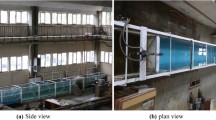Abstract
The dissolved oxygen concentration is an important index of water quality, and the atmosphere is one of the important sources of the dissolved oxygen. In this paper, the mass conservation law and the dimensional analysis method are employed to study the oxygen transfer under regular and non-breaking waves, and a unified oxygen transfer coefficient equation is obtained with consideration of the effect of kinetic energy and wave period. An oxygen transfer experiment for the intermediate depth water wave is performed to measure the wave parameters and the dissolved oxygen concentration. The experimental data and the least squares method are used to determine the constant in the oxygen transfer coefficient equation. The experimental data and the previous reported data are also used to further validate the oxygen transfer coefficient, and the agreement is satisfactory. The unified equation shows that the oxygen transfer coefficient increases with the increase of a parameter coupled with the wave height and the wave length, but it decreases with the increase of the wave period, which has a much greater influence on the oxygen transfer coefficient than the coupled parameter.
Similar content being viewed by others
References
SCHMID B. H., KOSKIAHO J. Artificial neural network modeling of dissolved oxygen in a wetland pond: The case of Hovi, Finland[J]. Journal of Hydrologic Engineering, 2006, 11(2): 188–192.
LIN J., XIE L. and PIETRAFESA L. J. et al. Dissolved oxygen stratification in two micro-tidal partially-mixed estuaries[J]. Estuarine, Coastal and Shelf Science, 2006, 70(3): 423–437.
JIRKA G. H., HERLINA H. and NIEPELT A. Gas transfer at the air-water interface: experiments with different turbulence forcing mechanisms[J]. Experiments in Fluids, 2010, 49(1): 319–327.
HANDLER R. A., SMITH G. B. Statistics of the temperature and its derivatives at the surface of a wind-driven air-water interface[J]. Journal of Geophysical Research, 2011, 116(C6): C06021.
RO K. S., HUNT P. G. and POACH M. E. Wind-driven surficial oxygen transfer[J]. Critical Reviews in Environmental Science and Technology, 2007, 37(6): 539–563.
TAYLOR P. K., YELLAND M. J. The dependence of sea surface roughness on the height and steepness of the waves[J]. Journal of Physical Oceanography, 2001, 31(2): 572–590.
FROST T., UPSTILL-GODDARD R. C. Meteorological controls of gas exchange at a small English Lake[J]. Limnology and Oceanography, 2002, 47(4): 1165–1174.
RO K. S., HUNT P. G. A new unified equation for wind-driven surficial oxygen transfer into stationary water bodies[J]. Transactions of the American Society of Agricultural and Biological Engineers, 2006, 49(5): 1615–1622.
BOETTCHER E. J., FINEBERG J. and LATHROP D. P. Turbulence and wave breaking effects on air-water gas exchange[J]. Physical Review Letters, 2000, 85(9): 2030–2033.
DANIIL E. I., GULLIVER J. S. Influence of waves on air-water gas transfer[J]. Journal of Environmental Engineering, 1991, 117(5): 522–540.
TSOUKALA V. K., MOUTZOURIS C. I. Scale effects in oxygenation in the breaker zone of coastal structures[C]. Proceedings of the 25th Coastal Engineering Conference. Orlando, Florida, USA, 1996, 1: 403–414.
YAKUSHEV E. V., VINOGRADOVA E. L. and DUBININ A. V. et al. On determination of low oxygen concentrations with Winkler technique[J]. Oceanology, 2012, 52(1): 122–129.
STEFANOVIC D. L. Measurement of temperature and dissolved oxygen in a lake under the ice cover[C]. Hydraulic measurements and experimental methods. Estes Park, Colorado, USA, 2002, 1–11.
BORSUK M. E., STOW C. A. and LUETTICH R. A. et al. Modelling oxygen dynamics in an intermittently stratified estuary: Estimation of process rates using field data[J]. Estuarine, Coastal and Shelf Science, 2001, 52(1): 33–49.
MANTHA R., TAYLOR K. and BISWAS N. et al. A continuous system for Fe0 reduction of nitrobenzene in synthetic wastewater[J]. Environmental Science and Technology, 2001, 35(15): 3231–3236.
DANIIL E. I., GULLIVER J. S. Temperature dependence of liquid film coefficient for gas transfer[J], Journal of Environmental Engineering, 1988, 114(5): 1224–1229.
NETO E. L., ZHU D. Z. and RAJARATNAM N. Dissolved oxygen downstream of an effluent outfall in an icecovered river: natural and artificial aeration[J]. Journal of Environmental Engineering, 2007, 133(11): 1051–1060.
Author information
Authors and Affiliations
Corresponding author
Additional information
Project supported by the National Natural Science Foundation of China (Grant Nos. 51009123, 50809065), the Natural Science Foundation of Shandong Province (Grant No. ZR2009FQ003).
Biography: Yin Ze-gao (1977-), Male, Ph. D., Associate Professor
Rights and permissions
About this article
Cite this article
Yin, Zg., David, Z.Z., Liang, Bc. et al. Theoretical analysis and experimental study of oxygen transfer under regular and non-breaking waves. J Hydrodyn 25, 718–724 (2013). https://doi.org/10.1016/S1001-6058(13)60417-5
Received:
Revised:
Published:
Issue Date:
DOI: https://doi.org/10.1016/S1001-6058(13)60417-5




